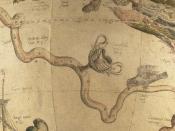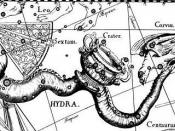The Mythological Hydra
Hydra is the Many Headed Monster and/or the Serpent of mythology. This enormous water snake called the swamps of Lerna its home in the ancient days. It had nine large heads altogether. One of which was totally immortal. Hydra also possessed a breath that killed anything instantly on contact.
Hydra's Discovery
Hydra was discovered by Charles Messier some time in early 1771. The open cluster was soon catalogued on February nineteenth, 1771. However, Charles Messier accidentally gave a wrong position in the catalogue, which caused Hydra to go missing until 1959, when T.F. Morris identified it. There are two other alleged discoveries/rediscoveries.
Location and facts of Hydra
The abbreviation of Hydra is Hya. It's right ascension is at 10 hours. Its declination is at -20 degrees. It is visible between 60 and -90 degrees. Hydra is the largest constellation in the sky. Once Hydra was much larger, but it was split into four parts known as the Sextans, Crater, Corvus, and Hydra).
Educated Estimations show that Hydra is around 300 million years old. Hydra should easily be seen with the naked eye, especially in April, at 9:00 PM, which is the best time to view it. Hydra is located between negative thirty degrees and ten degrees and fourteen to eight hours.
Hydra's Mythological History
There are two or more stories of Hydra. One tells that Hercules, with the help of Athena, located the Serpent Hydra's lair, which meant that there would be a long duel between Hercules and Hydra. Each of Hydra's heads would keep growing back after Hercules chopped them off. Hercules had to think if he wanted to beat Hydra. Hercules decided to get a torch and incinerate the neck stump of each head after he beheaded it with a torch. This made it so...


